Caryn
 In the early history of airplanes, they were used for things like mail. No one had really considered other uses, or if they did, the idea was far in the future in the minds of most people. Nevertheless, there was one man…William Bushnell Stout, who was an aeronautical engineer. William had previously designed several aircraft using principles similar to, and originally devised by Professor Hugo Junkers, the noted German all-metal aircraft design pioneer. Junkers was one of the mainstays of the German aircraft industry in the years between World War I and World War II. In particular his multi-engined all-metal passenger and freight planes helped establish airlines in Germany as well as all over the world. Stout designed planes using the same principles as Junkers had, but they were pretty much on paper. Then in the early 1920s, Ford Motor Company Henry Ford, along with a group of 19 other investors including his son Edsel, invested in the Stout Metal Airplane Company. Stout, a bold and imaginative salesman, sent a mimeographed form letter to leading manufacturers, asking for $1,000 and telling them, “For your one thousand dollars you will get one definite promise: You will never get your money back.” Stout raised $20,000, including $1,000 each from Edsel and Henry Ford. It’s hard for me to imagine that he would get even one investor, but I guess they figured he was, if nothing else, truthful.
In the early history of airplanes, they were used for things like mail. No one had really considered other uses, or if they did, the idea was far in the future in the minds of most people. Nevertheless, there was one man…William Bushnell Stout, who was an aeronautical engineer. William had previously designed several aircraft using principles similar to, and originally devised by Professor Hugo Junkers, the noted German all-metal aircraft design pioneer. Junkers was one of the mainstays of the German aircraft industry in the years between World War I and World War II. In particular his multi-engined all-metal passenger and freight planes helped establish airlines in Germany as well as all over the world. Stout designed planes using the same principles as Junkers had, but they were pretty much on paper. Then in the early 1920s, Ford Motor Company Henry Ford, along with a group of 19 other investors including his son Edsel, invested in the Stout Metal Airplane Company. Stout, a bold and imaginative salesman, sent a mimeographed form letter to leading manufacturers, asking for $1,000 and telling them, “For your one thousand dollars you will get one definite promise: You will never get your money back.” Stout raised $20,000, including $1,000 each from Edsel and Henry Ford. It’s hard for me to imagine that he would get even one investor, but I guess they figured he was, if nothing else, truthful.
The Ford Motor Company produced the Ford Trimotor in 1927. It was one of the first all-metal airplanes. It was often called the “Tin Goose” or “Flying Washboard.” It was the first plane that was designed to carry passengers rather than mail. Now, I don’t know about you, but the idea of flying in something called the Tin Goose or Flying Washboard, would not bring with it a feeling of confidence in the machine that was suppose to get me to my destination. I have to wonder how many people they were able to get to fly in the plane in those years. The plane was designed to carry twelve people and had three engines. The three engines allowed the plane to fly higher and faster than other airplanes or that time period. The plane could reach speeds of 130 miles per hour. The Ford 4-AT-15 Trimotor monoplane, which was piloted by Berndt Balehen, was first used in the first flight over the South Pole in November if 1929.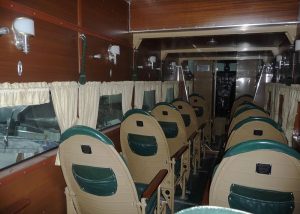
The interior of the plane was much like the interior of a passenger car on a train. Like most of the seats of any moving vehicle, design as come a long way, both in comfort and in safety, but at that time, it was state of the art. Now planes like this are a novelty item, that people go to see, because it is something they have never seen before, and may never see again. These days, the Tin Goose flies around the country being that novelty item. Recently it came to Casper, and I really wish I had been able to go see it and take a ride…maybe next time. It would be cool to fly in a Flying Washboard or a Tin Goose.
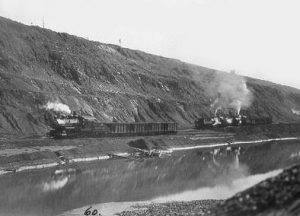 Over the centuries, metals or the discovery of metals have been something that has created everything from excitement to violence. Probably the best known discovery was that of gold, and while it is very valuable, there are many other very important metals, like iron, for instance. Very seldom do we think about all the things that are made with iron, and what an inexpensive, yet versatile metal it is. Iron is one of the most abundant metals found on earth, making up close to five percent of its crust. These iron minerals are typically mixed with clay, sand, rock or gravel. Iron is so common that it may be found in your backyard. Nevertheless, it is only mined commercially when the concentration is large enough to make it worth going after. Iron is used in cookware, fencing, vehicles, motors, buildings, and steel, just to name a few. And, every American born will need 27,416 pounds of iron in their lifetime.
Over the centuries, metals or the discovery of metals have been something that has created everything from excitement to violence. Probably the best known discovery was that of gold, and while it is very valuable, there are many other very important metals, like iron, for instance. Very seldom do we think about all the things that are made with iron, and what an inexpensive, yet versatile metal it is. Iron is one of the most abundant metals found on earth, making up close to five percent of its crust. These iron minerals are typically mixed with clay, sand, rock or gravel. Iron is so common that it may be found in your backyard. Nevertheless, it is only mined commercially when the concentration is large enough to make it worth going after. Iron is used in cookware, fencing, vehicles, motors, buildings, and steel, just to name a few. And, every American born will need 27,416 pounds of iron in their lifetime.
On this day September 5, 1844, iron ore was discovered in Minnesota’s Mesabi Range. The discovery was made  while the miners were on their way to prospect for gold. Because gold was the metal everyone was excited about, the iron ore was virtually ignored. As metals go, the iron would become far more valuable in northern Minnesota than gold. In fact, for the past 50 years, Lake Superior iron ore accounts for 90% of United States iron ore production, with much of that ore coming from the Mesabi Range, where that first discovery occurred back in 1844. Iron ore makes up the majority of Lake Superior shipping, and would soon become the most lucrative occupation in the Lake Superior shipping industry. Just imagine if you were one of those men who walked away from the iron ore discovery, in search of gold, which most never found. Wouldn’t you be kicking yourself now? There were millions to be made in the iron industry.
while the miners were on their way to prospect for gold. Because gold was the metal everyone was excited about, the iron ore was virtually ignored. As metals go, the iron would become far more valuable in northern Minnesota than gold. In fact, for the past 50 years, Lake Superior iron ore accounts for 90% of United States iron ore production, with much of that ore coming from the Mesabi Range, where that first discovery occurred back in 1844. Iron ore makes up the majority of Lake Superior shipping, and would soon become the most lucrative occupation in the Lake Superior shipping industry. Just imagine if you were one of those men who walked away from the iron ore discovery, in search of gold, which most never found. Wouldn’t you be kicking yourself now? There were millions to be made in the iron industry.
Shipping on Lake Superior is dominated by iron ore cargo. Of course, that is not the only thing shipped, but the 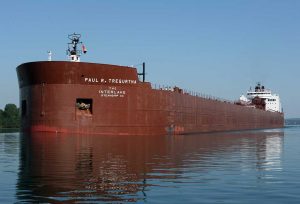 iron ore ships, which are always called ore boats, are among the most amazing in my book. The largest ore boat, the Paul R. Tregurtha is the reigning “Queen of the Lakes” title holder as the longest vessel on the Great Lakes at 1,013 feet 6 inches was constructed in two sections. When my mom, Collene Spencer, my sister, Cheryl Masterson, and I were in Superior three years ago, we got to see this amazing vessel as it left port. Of all the ships on Lake Superior, the ore boats are the ones most people think of when they think of ships on the lake. For people who make their living on the lake, the ore boats are their bread and butter. And to think it all started with a discovery that no one seemed to care about. In the end, it was an unexpected gold mine.
iron ore ships, which are always called ore boats, are among the most amazing in my book. The largest ore boat, the Paul R. Tregurtha is the reigning “Queen of the Lakes” title holder as the longest vessel on the Great Lakes at 1,013 feet 6 inches was constructed in two sections. When my mom, Collene Spencer, my sister, Cheryl Masterson, and I were in Superior three years ago, we got to see this amazing vessel as it left port. Of all the ships on Lake Superior, the ore boats are the ones most people think of when they think of ships on the lake. For people who make their living on the lake, the ore boats are their bread and butter. And to think it all started with a discovery that no one seemed to care about. In the end, it was an unexpected gold mine.
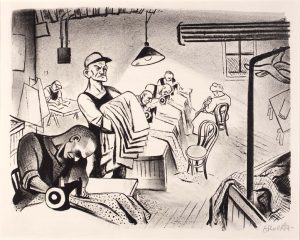 In a day and age when we see protests so often that we often pay very little attention, it’s easy to think that the protestors are just being ridiculous, and sometimes they are. That makes it easy to overlook the situations that really should be protested, or at least greeted with outrage. I suppose that every issue that is protested has its outrage, and sometimes the only way to get the attention an issue needs is to walk out and protest. Sometimes protests are simply the last resort.
In a day and age when we see protests so often that we often pay very little attention, it’s easy to think that the protestors are just being ridiculous, and sometimes they are. That makes it easy to overlook the situations that really should be protested, or at least greeted with outrage. I suppose that every issue that is protested has its outrage, and sometimes the only way to get the attention an issue needs is to walk out and protest. Sometimes protests are simply the last resort.
On this day, September 4, 1894, 12,000 tailors embarked on a strike to fight against the “sweatshop” system that exploited their labor. The tailors demanded that they be given a 10 hour work day, with an hour off for lunch. They wanted a weekly minimum wage and a weekly pay day. The “Protective Association” of cloakmaker manufacturers as well as important clothing dealers, “declared that they considered the demands of the men right, that no business which could not pay the workers the minimum wages asked ought to exist,” while “the 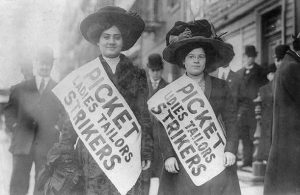 press and the public have also heartily sustained these demands, so that there can be no doubt that the public will pay, if necessary, the increased prices for the clothing rendered necessary.” While all that sounded good, the strike would continue through much of the fall. The striking workers said that the had to live half a year on what they could save out of the meager $4 per week they earned during the other half of the year. The year 1894 was a year of economic depression and widespread labor unrest. The strikes included the Pullman Strike, which paralyzed the railroads, and made Eugene Victor Debs America’s most important labor leader.
press and the public have also heartily sustained these demands, so that there can be no doubt that the public will pay, if necessary, the increased prices for the clothing rendered necessary.” While all that sounded good, the strike would continue through much of the fall. The striking workers said that the had to live half a year on what they could save out of the meager $4 per week they earned during the other half of the year. The year 1894 was a year of economic depression and widespread labor unrest. The strikes included the Pullman Strike, which paralyzed the railroads, and made Eugene Victor Debs America’s most important labor leader.
Labor conditions were atrocious in many cases, and the laborers often had little recourse. The big business owners had the control, and the laborers were at their mercy. If they wanted a job, they were to “shut up and do their job” or they wouldn’t have one. Many times these laborers had limited education, and so few options. 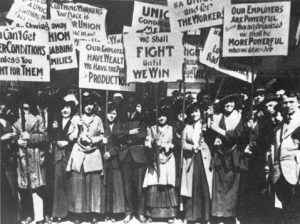 They also had families to support. Their wages were their lifeline, so they worked and worked, hoping that somehow they might create a better life for themselves and their families. These people were willing to work. All they asked for was a fair shake. Finally, they got to a point where they knew that they weren’t going to get that fair shake and they were left with no other options but to strike. It’s sad that it had to come to that point, but sometimes the strike and protest is all you have. There were other protests within the tailor industry, and many other industries too. Each one probably improved a few things, and eventually conditions got better. Of course, there will always be things to protest and people who will do so.
They also had families to support. Their wages were their lifeline, so they worked and worked, hoping that somehow they might create a better life for themselves and their families. These people were willing to work. All they asked for was a fair shake. Finally, they got to a point where they knew that they weren’t going to get that fair shake and they were left with no other options but to strike. It’s sad that it had to come to that point, but sometimes the strike and protest is all you have. There were other protests within the tailor industry, and many other industries too. Each one probably improved a few things, and eventually conditions got better. Of course, there will always be things to protest and people who will do so.

 My son-in-law, Kevin Petersen has been in our family for so long that it would be impossible to think of the family without him. Kevin started dating my daughter, Corrie when she turned 15…the age we had decided that she could date. They have been together ever since…a total of 26 years. These days it is difficult for me to imagine our family without Kevin in it. They have been married for 23 years after all. Kevin has always been a stabilizing influence in Corrie’s life. He is sensitive to her needs and emotions, and he has a way of bringing calm to her spirit. They have always looked to each other as a source of strength, humor, and happiness. They were perfect for each other from day one, and that has never changed.
My son-in-law, Kevin Petersen has been in our family for so long that it would be impossible to think of the family without him. Kevin started dating my daughter, Corrie when she turned 15…the age we had decided that she could date. They have been together ever since…a total of 26 years. These days it is difficult for me to imagine our family without Kevin in it. They have been married for 23 years after all. Kevin has always been a stabilizing influence in Corrie’s life. He is sensitive to her needs and emotions, and he has a way of bringing calm to her spirit. They have always looked to each other as a source of strength, humor, and happiness. They were perfect for each other from day one, and that has never changed.

Kevin and Corrie have two boys, Chris and Josh, and Kevin loves spending guy time with his sons. They love to go fishing, camping, and shooting. They used to love to play paintball, but these days they prefer real guns. I guess that the older the kids get the bigger and more impressive the toys become. Of course, one of the toys Kevin and the boys loved the most was the mud truck Kevin had. I guess there is nothing quite like getting down and dirty…for somebody who likes getting in the mud that is. I think I’ll pass on that sport, but Kevin really liked it. That truck sure came home muddy…ugh!! Nevertheless, times change, and mud trucking cost a lot of money. They decided to get out of it.


These days, Kevin, Corrie, and the boys spend as many weekends camping as they can possibly manage. Of course, with the boys working now, there are times when it’s just Kevin and Corrie. They love the quiet relaxation of the campgrounds. They don’t have to do anything they don’t want to. They just relax and enjoy the quiet life. As far as they are concerned, summer is for camping. Today is Kevin’s birthday. Happy birthday Kevin!! Have a great day, and a great camping weekend!! We love you!!
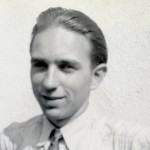
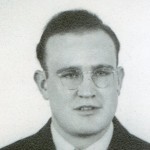 In August of 1964, my dad, Allen Spencer bought a Hollywood Reloading Press from his brother, William Spencer. Uncle Bill is two years older than my dad, and he loved his little brother, was always protective of him, and took him under his wing. As a little boy, Dad was really proud of his big brother, and wanted to say “brother” very badly, but he couldn’t quite get the word out correctly. Instead it always came out “Bowa” when Dad said it. After a while “Bowa” stuck, and the brothers both used it often. When Uncle Bill sent Dad the Reloading Press, he sent with it, a letter carefully explaining its safety instructions and its warnings. While going through Dad’s things, we came across that letter. It was such a treasure to find it, because it so perfectly depicted the relationship the brothers had.
In August of 1964, my dad, Allen Spencer bought a Hollywood Reloading Press from his brother, William Spencer. Uncle Bill is two years older than my dad, and he loved his little brother, was always protective of him, and took him under his wing. As a little boy, Dad was really proud of his big brother, and wanted to say “brother” very badly, but he couldn’t quite get the word out correctly. Instead it always came out “Bowa” when Dad said it. After a while “Bowa” stuck, and the brothers both used it often. When Uncle Bill sent Dad the Reloading Press, he sent with it, a letter carefully explaining its safety instructions and its warnings. While going through Dad’s things, we came across that letter. It was such a treasure to find it, because it so perfectly depicted the relationship the brothers had.
Always the big bowa, Uncle Bill was very excited that my dad wanted a reloading press, and since Uncle Bill was a gun dealer, who else would Dad have gone to when he wanted to make such a purchase. For those who don’t know, a Hollywood Reloading Press turns used ammunition into loaded ammunition again. Uncle Bill loved guns and all the accessories, and so it stood to reason that Dad would follow suit. The brothers had always used guns for hunting and safety, and even dynamite for blowing out tree stumps…and the occasional gate post. While boys would be boys, these boys weren’t troublemakers, but were rather careful and respected these items. They knew that improper use could be deadly. While my dad had grown up knowing about guns, Uncle Bill knew that he had not used a reloading press before, and he wanted to make sure nothing went wrong. It wasn’t that Uncle Bill thought my dad was careless, he just wanted him safe, and the reloader could bring danger, if not used correctly.
The letter, in my mind, was more about the love Uncle Bill had for my dad, than it was about the Hollywood 
 Reloading Press. Theirs was a close relationship that each of them treasured. Uncle Bill always loved writing letters. He always felt that the written documentation was forever. It carried with it the history of events that occurred in the life of the writer and the receiver. So few of us understand that, I think…at least not until it’s too late. The letter about the Hollywood Reloading Press will always be a treasure to all of my family. I’m sure that the letter was a treasure to my dad too, since he kept it all those years. And I will always think of “Bowa” when I think of the brothers now.
Reloading Press. Theirs was a close relationship that each of them treasured. Uncle Bill always loved writing letters. He always felt that the written documentation was forever. It carried with it the history of events that occurred in the life of the writer and the receiver. So few of us understand that, I think…at least not until it’s too late. The letter about the Hollywood Reloading Press will always be a treasure to all of my family. I’m sure that the letter was a treasure to my dad too, since he kept it all those years. And I will always think of “Bowa” when I think of the brothers now.
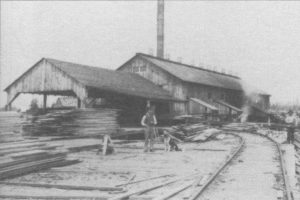
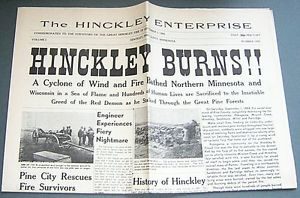 Every wildfire takes with it many victims. Humans, of course, are the most tragic, but they also take animals, homes, and plant life. When a fire gets out of control, devastation will soon follow. Often, all we think about is the loss, and that is a terrible thing, but sometimes something happens that brings a degree of victory and elation to an otherwise horrible situation. Such was the case in the September 1, 1894 Hinckley, Minnesota fire. The loss of life was devastating, with some accounts saying 440 and others saying 418…partly because the Indians weren’t counted in that amount, and partly because there were people who were never found.
Every wildfire takes with it many victims. Humans, of course, are the most tragic, but they also take animals, homes, and plant life. When a fire gets out of control, devastation will soon follow. Often, all we think about is the loss, and that is a terrible thing, but sometimes something happens that brings a degree of victory and elation to an otherwise horrible situation. Such was the case in the September 1, 1894 Hinckley, Minnesota fire. The loss of life was devastating, with some accounts saying 440 and others saying 418…partly because the Indians weren’t counted in that amount, and partly because there were people who were never found.
The upper Midwest of the United States was a wooded area, rich in timber. Hinckley was a lumber and rail town, that had been built along the Grindstone River in Minnesota near the Wisconsin border. The main industry was the lumber business, and the slash cutting technique left behind it large amounts of wood debris. The town was nicknamed The Town Built Of Wood. Little did they know what a tragic nickname that would turn out to be. The lumber yards were built quite close to the railroad tracks, and the sparks from the 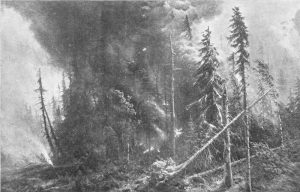 trains often set the wood debris on fire. Those fires were problematic, but no one expected the part the trains would play in 1894. That summer, a drought hit the Upper Midwest, making fires much more dangerous. The whole situation exploded on September 1, 1894, when fires near two rail lines south of Hinckley broke out, spreading north. When the raging fire reached the train depot, 350 of the residents got on a train to escape. The train passed right through flames, but reached safety in West Superior, Wisconsin. Were it not for this train, the loss of life would have been much higher. A number of the town’s residents took refuge in the swamps near town, but many of these people were killed, sadly some of them died by drowning. About 100 other residents fled to a gravel pit filled with water, and most of those people managed to survive. A train that was entering Hinckley from the north reversed direction to avoid the blaze. It still caught fire, and the only survivors were those who were able to jump from the train into a lake.
trains often set the wood debris on fire. Those fires were problematic, but no one expected the part the trains would play in 1894. That summer, a drought hit the Upper Midwest, making fires much more dangerous. The whole situation exploded on September 1, 1894, when fires near two rail lines south of Hinckley broke out, spreading north. When the raging fire reached the train depot, 350 of the residents got on a train to escape. The train passed right through flames, but reached safety in West Superior, Wisconsin. Were it not for this train, the loss of life would have been much higher. A number of the town’s residents took refuge in the swamps near town, but many of these people were killed, sadly some of them died by drowning. About 100 other residents fled to a gravel pit filled with water, and most of those people managed to survive. A train that was entering Hinckley from the north reversed direction to avoid the blaze. It still caught fire, and the only survivors were those who were able to jump from the train into a lake.
The fire burned 300,000 acres of town and forest, causing about $25 million in damages. In Hinckley, 228 people died, and another 200 in the surrounding areas, including 23 Ojibwa natives. It was a firestorm, with “as much force as an atomic bomb,” to quote a display at the town museum. Hinckley’s afternoon inferno also burned burned up five surrounding villages as it consumed over 400 square miles of kindling. It became known as the Great Hinckley Fire. A small group of statues in town represents survivors in the gravel pit. The Fire Monument and mass grave is on Fire Monument Road, very near the current interstate. Mass graves of 248 people are 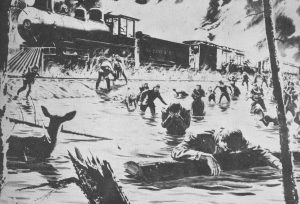
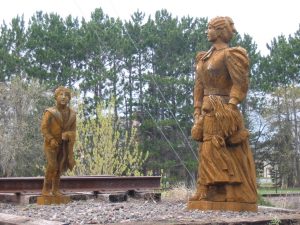 in lumpy mounds just behind the marker, dedicated in 1900 to the pioneers of civilization in Minnesota. Boston Corbett, killer of Abe Lincoln’s killer, is said to have left his “hole-in-the-ground home” in Kansas and died in the Great Hinckley Fire, in the neighboring town of Neodesha. The town of Hinckley has decided that the nickname The Town Built Of Wood is not one they want anymore, and their current slogan is “Relax…Have Fun!”
in lumpy mounds just behind the marker, dedicated in 1900 to the pioneers of civilization in Minnesota. Boston Corbett, killer of Abe Lincoln’s killer, is said to have left his “hole-in-the-ground home” in Kansas and died in the Great Hinckley Fire, in the neighboring town of Neodesha. The town of Hinckley has decided that the nickname The Town Built Of Wood is not one they want anymore, and their current slogan is “Relax…Have Fun!”

 It’s inevitable…the end of summer, turns into the first day of school. All the kids are torn between being bored from too much free time, and the dread of getting back into the grind of studying and homework. This year finds my family with just one public school student left. Our grandson, Josh Petersen is a senior in high school this year, so this is our last year with the public school system…until the great grandbabies start coming anyway. I am finding that hard to believe.
It’s inevitable…the end of summer, turns into the first day of school. All the kids are torn between being bored from too much free time, and the dread of getting back into the grind of studying and homework. This year finds my family with just one public school student left. Our grandson, Josh Petersen is a senior in high school this year, so this is our last year with the public school system…until the great grandbabies start coming anyway. I am finding that hard to believe.
Of course, once the kids get going, most of them enjoy school. Believe it or not, humans tend to want to be productive and for kids that does mean school. By the end of the year, they are ready for summer break, but by summer’s end, they are ready to get back into the swing of things again. They miss the organized sports, friends they don’t see except at 

 school, getting out of the house or daycare, and in reality, most of them actually enjoy learning. I don’t think any of us really want to go through life with no mental stimulation, and that is exactly what school does for the kids, whether they particularly like it or not.
school, getting out of the house or daycare, and in reality, most of them actually enjoy learning. I don’t think any of us really want to go through life with no mental stimulation, and that is exactly what school does for the kids, whether they particularly like it or not.
Then, of course, most kids usually get a few new articles of clothing to start out the new school year. For some, it is a matter of necessity, because of course, they have grown so much since last year, and for others, it is a necessity, because after all, you have to have at least one new outfit to start the year…right? And those new 
 clothes and school supplies tend to take the sting of summer’s end out of the picture, a little bit anyway. I always thought it was fun to have new school supplies, even if the newness wore off pretty quickly.
clothes and school supplies tend to take the sting of summer’s end out of the picture, a little bit anyway. I always thought it was fun to have new school supplies, even if the newness wore off pretty quickly.
And so, as the kids come home after school, they are filled with stories of their day to pass on to their parents, and even a little bit of excitement just to be back…until they start to think about the homework they have to get done before school tomorrow. And then, there is the lack of outdoor playtime, because they have to get ready for the next day. That might be a bit of a let down, but that is what getting back into the swing of things is all about.
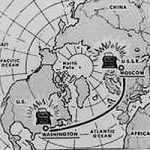 The United States and Russia have long been frenemies, truth be told, but in October of 1962, no one would have called them that. The Cuban Missile Crisis brought the two super powers to the brink of a nuclear conflict. As we all know, that would have been devastating for the inhabitants of the earth, and in the end, both countries agreed that we could not let things escalate to that level again. In June of 1963, American and Russian representatives agreed to establish a “hot line” between Moscow and Washington DC. The idea was to speed communication between the two governments to prevent an accidental war.
The United States and Russia have long been frenemies, truth be told, but in October of 1962, no one would have called them that. The Cuban Missile Crisis brought the two super powers to the brink of a nuclear conflict. As we all know, that would have been devastating for the inhabitants of the earth, and in the end, both countries agreed that we could not let things escalate to that level again. In June of 1963, American and Russian representatives agreed to establish a “hot line” between Moscow and Washington DC. The idea was to speed communication between the two governments to prevent an accidental war.
By August of 1963, the system was ready to be tested. American teletype machines were installed in the Kremlin and at the Pentagon. Many people have thought that the machine at the Pentagon was actually in the White House, but that is incorrect. The two nations exchanged 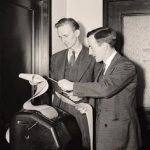 encoding devises so that they could decipher the messages. This would allow the two nations to message each other in a matter of minutes. That would be somewhat slow in today’s high tech world of cell phones and texting, but in those days, it was state of the art. Once received, the message would have to be deciphered, which did slow things down a bit, but again, at that time, it was state of the art. The two teletype machines were connected by a 10,000 mile long cable with “scramblers” along the way to ensure that the messages could not be intercepted by unauthorized personnel.
encoding devises so that they could decipher the messages. This would allow the two nations to message each other in a matter of minutes. That would be somewhat slow in today’s high tech world of cell phones and texting, but in those days, it was state of the art. Once received, the message would have to be deciphered, which did slow things down a bit, but again, at that time, it was state of the art. The two teletype machines were connected by a 10,000 mile long cable with “scramblers” along the way to ensure that the messages could not be intercepted by unauthorized personnel.
On August 30, the United States sent its first message to the Soviet Union over the hot line: “The quick brown fox jumped over the lazy dog’s back 1234567890.” The message was chosen because it used every letter and number key on the teletype machine in order to see that each was in working order. Moscow returned a message in Russian indicating that every key had worked properly. In the end, the hot line was never needed 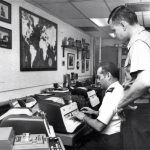 to prevent war, but instead has become a novelty item, used as a prop in movies about nuclear disaster. Fail Safe and Dr Strangelove were two movies that utilized the machines. The reality was that the two superpowers had come so close to mutual destruction back in 1962, that neither had much stomach for the proposed threat. They understood that communication was key in stopping a nuclear war. Of course, that has not stopped other nations from threatening to use nuclear weapons against other nations of the world. The Cold War ended a long time ago, but the “hot line” is still in operation between the two superpowers, and has since been supplemented by a direct secure telephone connection in 1999.
to prevent war, but instead has become a novelty item, used as a prop in movies about nuclear disaster. Fail Safe and Dr Strangelove were two movies that utilized the machines. The reality was that the two superpowers had come so close to mutual destruction back in 1962, that neither had much stomach for the proposed threat. They understood that communication was key in stopping a nuclear war. Of course, that has not stopped other nations from threatening to use nuclear weapons against other nations of the world. The Cold War ended a long time ago, but the “hot line” is still in operation between the two superpowers, and has since been supplemented by a direct secure telephone connection in 1999.

 My niece, Lindsay Moore, is a social butterfly. She never had any trouble making new friends, and everyone who knows her, loves her. It’s a personality trait that Lindsay has. She can talk to anyone…and feel no shyness, and her friendship ability is coupled with her genuine caring nature. I remember when she was a teenager, and I would see her at church, before the service, talking to some of the other members of the congregation. It didn’t matter how old they were, or how young, Lindsay could talk to any of them. I always found the way she was when talking to some of the older members of the congregation to be the sweetest thing to watch. I remember when she was talking to a woman named Fern one time. I’m not sure how old Fern was at the time, but at least mid-seventies I would think. Lindsay went up and hugged her and then sat down to visit with her for a minute. Fern was obviously pleased that this teenager cared enough to talk to her, but it was also obvious that it wasn’t their first conversation. They were talking like friends, because they were friends. I know that Lindsay was just being Lindsay, but I can tell you that her actions affected more than one person in church that day. Fern, of course was very blessed by the sweet, loving girl who was sharing a moment with her, but there were others too. I noticed several other members of the congregation looking on with a sense of…well, pride, almost as if they had something to do with how Lindsay had turned out. They didn’t, of course, but she was a member of the church, and that gave them a sense of family, and therefore pride at how kind she was to Fern. For me…well, it was a picture that has been stored in my memory files since that day. Her way of making people feel important is something I’ll never forget about Lindsay.
My niece, Lindsay Moore, is a social butterfly. She never had any trouble making new friends, and everyone who knows her, loves her. It’s a personality trait that Lindsay has. She can talk to anyone…and feel no shyness, and her friendship ability is coupled with her genuine caring nature. I remember when she was a teenager, and I would see her at church, before the service, talking to some of the other members of the congregation. It didn’t matter how old they were, or how young, Lindsay could talk to any of them. I always found the way she was when talking to some of the older members of the congregation to be the sweetest thing to watch. I remember when she was talking to a woman named Fern one time. I’m not sure how old Fern was at the time, but at least mid-seventies I would think. Lindsay went up and hugged her and then sat down to visit with her for a minute. Fern was obviously pleased that this teenager cared enough to talk to her, but it was also obvious that it wasn’t their first conversation. They were talking like friends, because they were friends. I know that Lindsay was just being Lindsay, but I can tell you that her actions affected more than one person in church that day. Fern, of course was very blessed by the sweet, loving girl who was sharing a moment with her, but there were others too. I noticed several other members of the congregation looking on with a sense of…well, pride, almost as if they had something to do with how Lindsay had turned out. They didn’t, of course, but she was a member of the church, and that gave them a sense of family, and therefore pride at how kind she was to Fern. For me…well, it was a picture that has been stored in my memory files since that day. Her way of making people feel important is something I’ll never forget about Lindsay.
Lindsay has had the opportunity to live a number of places in her life. She was born in Casper, Wyoming, but has lived in South Dakota, Florida, and North Carolina. Her husband’s work as a college special teams coach also gives them the opportunity to travel to recruit players, so she has been a lot of places. I’ve often wondered if the moves were difficult. Being somewhat shy, myself, it is hard for me to imagine making new 
 friends every time another move was necessary, but Lindsay really has no trouble. Everywhere she has lived, she makes new friends quickly. Then when she has to move, she remains friends with the people she has met…for life. I think it all goes back to that ability to share a moment with people. Then moments turn into a friendship that forms because Lindsay genuinely cares about people, and people want to be friends with people like that. Today is Lindsay’s birthday. Happy birthday Lindsay!! Have a great day!! We love you!!
friends every time another move was necessary, but Lindsay really has no trouble. Everywhere she has lived, she makes new friends quickly. Then when she has to move, she remains friends with the people she has met…for life. I think it all goes back to that ability to share a moment with people. Then moments turn into a friendship that forms because Lindsay genuinely cares about people, and people want to be friends with people like that. Today is Lindsay’s birthday. Happy birthday Lindsay!! Have a great day!! We love you!!
 My father-in-law, Walt Schulenberg would have turned 87 today. In the three years and almost four months since he went to Heaven, I can say that I have missed him very much, and yet it’s been like he never really left. Alzheimer’s Disease has taken the memory of her husband’s passing away from my mother-in-law, along with the passing of her parents and her daughter. It isn’t a bad thing for her, because she doesn’t have to experience the grief the rest of us have to go through. Nevertheless, because of her condition, I…we, the family have had to keep up the charade that Dad, Marlyce, and the Knox grandparents are still alive.
My father-in-law, Walt Schulenberg would have turned 87 today. In the three years and almost four months since he went to Heaven, I can say that I have missed him very much, and yet it’s been like he never really left. Alzheimer’s Disease has taken the memory of her husband’s passing away from my mother-in-law, along with the passing of her parents and her daughter. It isn’t a bad thing for her, because she doesn’t have to experience the grief the rest of us have to go through. Nevertheless, because of her condition, I…we, the family have had to keep up the charade that Dad, Marlyce, and the Knox grandparents are still alive.

There is a song that Tim McGraw sings about a girlfriend that broke up with her boyfriend because he wanted to move away and she didn’t. He never quite got over her, and in his imagination, he saw her in all the places he traveled. For the man in the song, I’m sure the visions were somewhat torturous, but for my mother-in-law, they are a blessing. She sees Dad in some of the men at the nursing home, in her sons and even grandsons, and she has it in her mind that he is simply in the garage, at the neighbors, or at Walmart. When she asks about him, I always tell her that he is at Walmart, and he will be back later. That satisfies her, because she knows that he would never leave her. And we know it too.
 I have to wonder if Dad ever thought about all the places he would be see after he left for Heaven. We tend to think that when we pass away, we will only live on in the hearts of our loved ones, and that’s true, but the mind is a funny thing. Our imaginations can place our loved ones in places they really aren’t…whether our mind is sharp or not. There are many times I can see my mom and dad, my father-in-law, sister-in-law, and grandparents in many memories that I have filed away in my memory files, but I think that most of the time, my memories aren’t nearly a vivid as my mother-in-law’s, and that’s ok, because it allows my father-in-law to keep his promise, never to leave her, alive in my mother-in-law’s life. Happy birthday in Heaven Dad. We love and miss you very much.
I have to wonder if Dad ever thought about all the places he would be see after he left for Heaven. We tend to think that when we pass away, we will only live on in the hearts of our loved ones, and that’s true, but the mind is a funny thing. Our imaginations can place our loved ones in places they really aren’t…whether our mind is sharp or not. There are many times I can see my mom and dad, my father-in-law, sister-in-law, and grandparents in many memories that I have filed away in my memory files, but I think that most of the time, my memories aren’t nearly a vivid as my mother-in-law’s, and that’s ok, because it allows my father-in-law to keep his promise, never to leave her, alive in my mother-in-law’s life. Happy birthday in Heaven Dad. We love and miss you very much.

